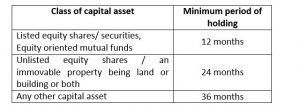Here some tips for you on how to compute your capital gains for the purpose of filing tax return
Have you earned capital gain on transfer of certain capital asset during the financial year ending 31st March 2018 and are you ready to file your income tax return after incorporating such capital gain? Here some tips for you on how to compute your capital gain for the purpose of disclosure in tax return.
What are capital gains?
Capital gain is the profit that the investor earns when he transfers a capital asset for a price higher than the purchase price. Capital asset means any kind of property held by the assessee other than:
1. Stock in trade, consumable stores or raw materials held for the purpose of business or profession
2. Personal effects that are movable property held for personal use but excludes jewellery, archaeological collection, drawings, paintings, sculptures or any work of art
3. Agricultural land in certain areas, 6 percent or 7 percent gold bonds, National defence bonds, special bearer bonds, and gold deposit bonds under the gold deposit scheme.
Computing capital gains can be a complex and challenging task depending on the nature and number of financial transactions undertaken by the assessee. Income-tax form requires mandatory disclosure of all capital gains realized during the year. The tax rate for these gains depend on the asset class and the holding period. On the basis of the holding period the capital asset are further divided into short term and long term capital assets.
Holding period
The holding period is calculated from date the asset was acquired by the assessee till the date immediately preceding the date of transfer of the asset. The following table illustrates the minimum period of holding which would classify a capital asset as long-term asset.

Capital gain tax rates
The capital gain tax rate for a resident is as under:

You can minimise your tax on LTCG arising from certain capital assets by investing net consideration or capital gain in certain specified assets. For example, long term capital gain arising on transfer of residential property can be invested into another residential property within specified period and in that event no capital gain tax is payable if the whole of the amount of capital gain is invested or if part amount is invested then tax shall be payable only on the shortfall.
Similarly, on transfer of any other long term capital asset (only land or building or both from AY2019-20 onward) one can invest in certain specified bonds within 6 months from the date of transfer. The taxpayer can invest whole or part of capital gains in such bonds subject to maximum of Rs 50 lakh.
Disclosure in ITR
Once you computed your capital gains or losses, the next step is to include them in your ITR form. There are different ITR forms based on the type and amount of income. Individuals with income from salary and capital gains are required to file ITR 2. While individuals with income from business or profession and capital gain are required to file ITR 3.
Even if capital gains earned are tax-exempt, they need to be disclosed in the return in schedule EL.


